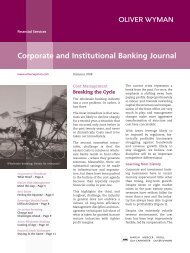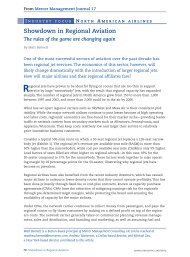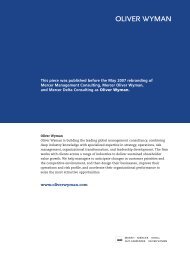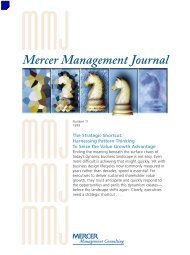Download the Report - Oliver Wyman
Download the Report - Oliver Wyman
Download the Report - Oliver Wyman
You also want an ePaper? Increase the reach of your titles
YUMPU automatically turns print PDFs into web optimized ePapers that Google loves.
Exhibit 2 Restating <strong>the</strong> current business (illustrative auto industry example)<br />
Economic Neighborhoods<br />
Auto<br />
manufacturing<br />
Used car sales<br />
Insurance<br />
Fleet management<br />
Our strength<br />
We play here<br />
Competitor<br />
strength<br />
White space<br />
Economically<br />
unattractive<br />
Differentiated<br />
products<br />
Branded<br />
products<br />
Low cost<br />
Installed base<br />
One-stop shop<br />
Facilities manager<br />
Value chain player<br />
Outsourcer<br />
Pyramid<br />
Information<br />
management<br />
Asset management<br />
De facto standard<br />
Downstream<br />
player<br />
Solution<br />
Components supplier<br />
Business Designs<br />
The map often reveals unexpected and enlightening patterns. For example, most large companies<br />
play in ei<strong>the</strong>r a few economic neighborhoods served through many business designs, or in many<br />
neighborhoods and relatively few business designs. One CEO, after working through <strong>the</strong> process of<br />
developing a Portfolio Map for his diversified manufacturing company, commented:<br />
“Now I understand what I am dealing with. Several of our businesses are based on <strong>the</strong><br />
‘innovation’ design, where we live and die by inventing new products. These businesses<br />
will be profitable to <strong>the</strong> extent that we support smart R&D and develop products that<br />
meet real customer needs and get <strong>the</strong>m to market more quickly than our competitors.<br />
O<strong>the</strong>r businesses we own use <strong>the</strong> ‘service’ design. The value-capture mechanism in <strong>the</strong>se<br />
is our ability to keep customer processes running efficiently and with minimal interruption<br />
around <strong>the</strong> clock. But three of our businesses are built on <strong>the</strong> ‘brand’ design, where<br />
we are selling technology products into <strong>the</strong> general consumer marketplace in competition<br />
with companies like Sony. In that game, it’s necessary to spend tens of millions of dollars on<br />
advertising just to build and maintain mindshare. Frankly, as an engineering company, we<br />
aren’t comfortable with that kind of marketing spending, and we have no real idea how to<br />
do it right. That’s where <strong>the</strong> big downside risk is lurking in our portfolio.”<br />
The portfolio value mapping process yields several specific and useful insights:<br />
TBusiness designs tend to repeat across your portfolio. So making one set of moves has <strong>the</strong><br />
potential to trigger growth or performance improvement across large sections of your<br />
company, not just in one place—if your organization can channel <strong>the</strong> learning.<br />
TThe evolution of business designs tends to be predictable, because patterns emerge that have already<br />
played out in o<strong>the</strong>r sectors, just not yet in yours. Divisions or units with common business<br />
designs tend to share <strong>the</strong> same risks and opportunities in <strong>the</strong>ir respective marketplaces.<br />
You can build “playbooks” and plan out your next moves with a higher chance of success.<br />
TMost portfolios tend to be relatively concentrated in business design terms, with five or six designs<br />
usually accounting for up to 80 percent of a portfolio. You are no longer running twenty or<br />
fifty units, but five or ten business designs. The job just got easier because <strong>the</strong> vantage<br />
point got higher.<br />
6 Portfolio redesign Mercer Management Journal
















